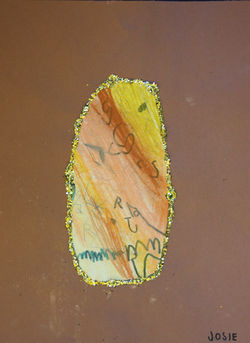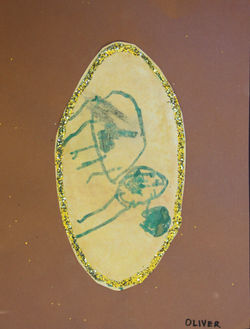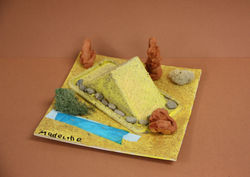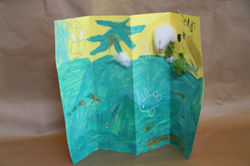
Student Art Gallery 2017-2018
 |
|---|
 |
 |
 |
 |
 |
 |
 |
 |
 |
 |
 |
 |
 |
 |
 |
 |
 |
 |
 |
 |
 |
 |
 |
 |
 |
 |
 |
 |
 |
 |
 |
 |
 |
 |
 |
The Kindergartners are both artists and historians at Laurence, and as they travel across the world they make art along the way! The first stop on our art history adventure was Ancient Egypt. The Kindergartners discovered the ancient system of writing in Egypt: hieroglyphics. They each created their own pastel hieroglyphics, embellished with glittering sand.
Egyptian Hieroglyphics
markers & pastel
Ancient Egyptian Landscaping
Multimedia
The Kindergartners considered the landscape and environment of ancient Egypt with their pyramid dioramas. They painted golden sand, added blue cellophane representing the Nile river and completed the scene with the Great Sphinx of Giza sculpted out of clay.
 |  |
|---|---|
 |  |
 |  |
 |  |
 |  |
 |  |
 |  |
 |  |
 |  |
 |  |
 |  |
 |  |
 |  |
 |  |
 |  |
 |  |
 |  |
 |  |
 |  |
 |  |
 |  |
 |  |
 |  |
 |  |
 |  |
 |
|---|
 |
 |
 |
 |
 |
 |
 |
 |
 |
 |
 |
 |
 |
 |
 |
 |
 |
 |
 |
 |
 |
 |
 |
 |
 |
 |
Grecian Urns
Air-dry clay & tempera paint
The Kindergartners visited Ancient Greece and learned about the various vessels used for storing wine, water, and perfume. Using air-dry clay, students sculpted ‘amphorae’, which is a type of urn or vase with two expansive handles joining the shoulder of the body and a long neck. Afterward, students painted the clay vase with decorative geometric patterns.
Japanese Noh Masks
Paper collage
We traveled to Japan and learned about Noh theater, the classical art form that dates back to the 14th century! We discovered that actors in Noh theater wear ornate masks describing a range of possible characters: men, women, demons, ghosts, animals, or spirits. Each student selected a character and created a colorful collage, using shapes to convey their character's emotion.
 |
|---|
 |
 |
 |
 |
 |
 |
 |
 |
 |
 |
 |
 |
 |
 |
 |
 |
 |
 |
 |
 |
 |
 |
 |
 |
 |
 |
 |
 |
 |
 |
 |
 |
 |
 |
 |
 |
 |
 |
 |
 |
|---|
 |
 |
 |
 |
 |
 |
 |
 |
 |
 |
 |
 |
 |
 |
 |
 |
 |
 |
 |
 |
 |
 |
 |
 |
 |
 |
 |
 |
 |
 |
 |
 |
 |
 |
 |
 |
 |
 |
 |
 |
 |
 |
 |
 |
 |
 |
 |
 |
 |
 |
 |
 |
 |
 |
 |
 |
 |
 |
 |
 |
 |
 |
 |
 |
 |
 |
 |
 |
 |
 |
 |
 |
 |
 |
 |
Japanese Byobu Screens
Acrylic paint & oil pastel
While we were in Japan, the Kindergartners also learned about Japanese folding screens or Byobu screens. Byobu literally translates as “windwall”, and these screens were essentially moveable walls, used within shared spaces to allow for flexible privacy. These screens would often have elaborate paintings and calligraphy, each panel would telling a horizontal narrative. The Kindergartners painted a dazzling story on their own large-scale folding screens.
Japanese
Shibori Textiles
Indigo dye
We also studied Japanese’s rich textile heritage and made our own manual resist shibori textiles with indigo dye. The Kindergartners made their own shibori textiles by twisting, bunching, and tying cloth, then submerging the cloth into a vat of indigo dye. They experienced the effects of exposing the natural plant based indigo mixture to oxygen, as the dye would change from bright green to a rich blue. Upon unfolding they learned that the resulting patterns described which folding techniques they had practiced.
 |  |
|---|---|
 |  |
 |  |
 |  |
 |  |
 |  |
 |  |
 |  |
 |  |
 |  |
 |  |
 |  |
 |  |
 |  |
 |  |
 |  |
 |  |
 |  |
 |  |
 |  |
 |  |
 |  |
 |  |
 |  |
Medieval Castle Architecture
As we moved into Medieval art the students looked at castles and considered the materials and details used to secure royalty. Each Kindergartner created their own 3d fortress out of heavyweight paper. They first printed a grey texture on the paper to represent stone, then they added details: a drawbridge and ramparts. Some Kindergarten artists even added knights, and alligators in their moats!
 |  |
|---|---|
 |  |
Triptych
Tempera paint & gold ink
The Kindergartners created their own three fold paintings based on the alter-pieces we looked at from Medieval Europe. We learned that triptychs were a type of portable artwork that could be folded shut, protected from exterior elements that may damage the imagery. Each student painted a magnificent triptych with a story of their own invention and added glimmering metallic paints to mimic the gold leaf technique that frequented medieval manuscripts.
 |
|---|
 |
 |
 |
 |
 |
 |
 |
 |
 |
 |
 |
 |
 |
 |
 |
 |
 |
 |
 |
 |
 |
 |
 |
 |
 |
 |
 |
 |
 |
 |
 |
 |
 |
 |
 |
 |
 |
 |
 |
 |
 |
 |
 |
 |
 |
 |
 |
 |
 |
 |
 |
 |
 |
 |
 |
 |
 |
 |
 |
 |
 |
 |
 |
 |
 |
 |
 |
 |
 |
 |
 |
 |
|---|
 |
 |
 |
 |
 |
 |
 |
 |
 |
 |
 |
 |
 |
 |
 |
Renaissance Frescos
Watercolor & plaster
As we made our way to Renaissance Italy, we discovered the technique that frequents Italian homes, monuments, and chapels: Fresco paintings. We looked at the Italian masters such as Michelangelo and Botticelli and learned that Fresco painting takes patience but has lasting results. We mixed our own plaster, then used watercolor paint, which absorbed into the surface. Each Kindergartner created a detailed fresco inspired by Botticelli’s Primevera painting.